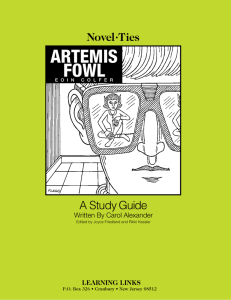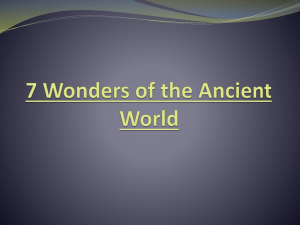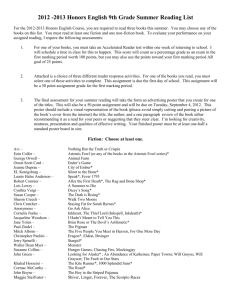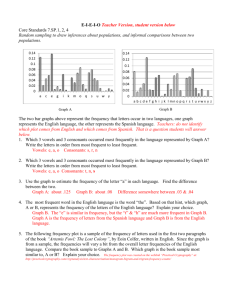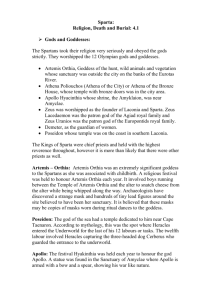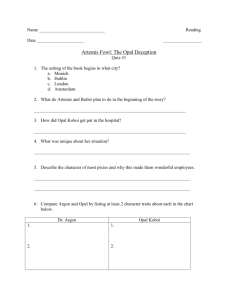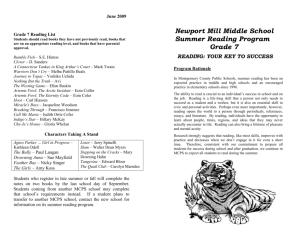File
advertisement
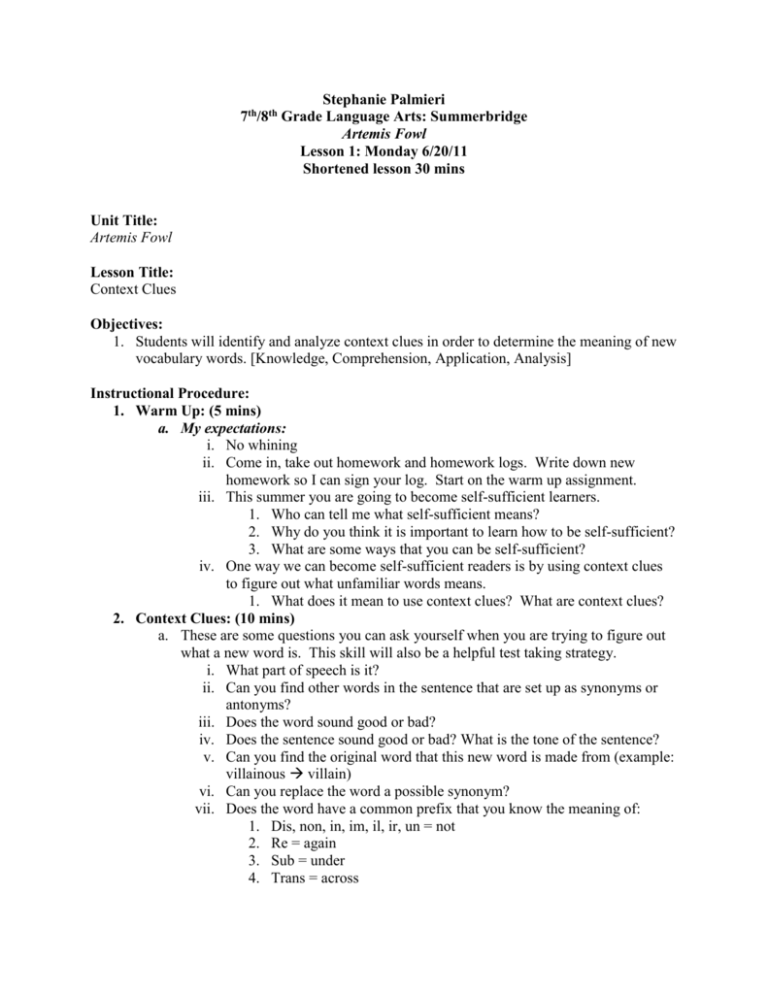
7th/8th Stephanie Palmieri Grade Language Arts: Summerbridge Artemis Fowl Lesson 1: Monday 6/20/11 Shortened lesson 30 mins Unit Title: Artemis Fowl Lesson Title: Context Clues Objectives: 1. Students will identify and analyze context clues in order to determine the meaning of new vocabulary words. [Knowledge, Comprehension, Application, Analysis] Instructional Procedure: 1. Warm Up: (5 mins) a. My expectations: i. No whining ii. Come in, take out homework and homework logs. Write down new homework so I can sign your log. Start on the warm up assignment. iii. This summer you are going to become self-sufficient learners. 1. Who can tell me what self-sufficient means? 2. Why do you think it is important to learn how to be self-sufficient? 3. What are some ways that you can be self-sufficient? iv. One way we can become self-sufficient readers is by using context clues to figure out what unfamiliar words means. 1. What does it mean to use context clues? What are context clues? 2. Context Clues: (10 mins) a. These are some questions you can ask yourself when you are trying to figure out what a new word is. This skill will also be a helpful test taking strategy. i. What part of speech is it? ii. Can you find other words in the sentence that are set up as synonyms or antonyms? iii. Does the word sound good or bad? iv. Does the sentence sound good or bad? What is the tone of the sentence? v. Can you find the original word that this new word is made from (example: villainous villain) vi. Can you replace the word a possible synonym? vii. Does the word have a common prefix that you know the meaning of: 1. Dis, non, in, im, il, ir, un = not 2. Re = again 3. Sub = under 4. Trans = across b. Example (I will model) i. “How does one describe Artemis Fowl? Various psychiatrists have tried and failed. The main problem is Artemis’s own intelligence. He bamboozles every test thrown at him. He has puzzled the greatest medical minds, and sent many of them gibbering to their own hospitals” (pg. 1). ii. Figuring out the two words 1. I identified the tone of the sentence through other words. Words like failed and problem are negative, leading me to believe that bamboozle is also negative. 2. Intelligence is also connected with bamboozles. If he is intelligent, a synonym for bamboozles might be something like completes, conquers, dominates, etc. 3. Gibbering is connected with puzzled. Puzzled means stumped or confused. Because that word is negative, gibbering is also negative. 4. The went gibbering to their hospitals. Hospital is a place you go when something is wrong or you are sick, so gibbering might mean something is wrong with them. 3. Context Clues Practice (12 mins) a. I will give each student 2 sentences from the book that contain difficult words. b. Students will work individually. They will use the context clue strategies to identify a possible meaning for the word and write it next to the word on the paper. i. If they already know what the word means, what clues can they point out to others? c. What context clues/strategies did you use to decipher that word’s possible meaning. 4. Wrap Up: (3 mins) a. Share one or two b. Explain homework 5. Homework: a. Look up the real definition of the words in your sentences. On the back of each paper, rewrite the word, write the definition for each word and illustrate the meaning of each word. We will be using these tomorrow in class so please make sure your handwriting is legible. Assessment: 1. Context clue in class assignment 2. Homework for tomorrow Materials: 1. Self-Sufficient sign 2. Sentences on board for modeling 3. Context clues checklist 4. Practice sentences on separate sheets of paper Context Clues Checklist 1. What part of speech is it? 2. Can you find other words in the sentence that are set up as synonyms or antonyms? 3. Does the word sound good or bad? 4. Does the sentence sound good or bad? What is the tone of the sentence? 5. Can you find the original word that this new word is made from (example: villainous villain) 6. Can you replace the word a possible synonym? 7. Does the word have a common prefix that you know the meaning of: a. Dis, non, in, im, il, ir, un = not b. Re = again c. Sub = under d. Trans = across Context Clues Checklist 1. What part of speech is it? 2. Can you find other words in the sentence that are set up as synonyms or antonyms? 3. Does the word sound good or bad? 4. Does the sentence sound good or bad? What is the tone of the sentence? 5. Can you find the original word that this new word is made from (example: villainous villain) 6. Can you replace the word a possible synonym? 7. Does the word have a common prefix that you know the meaning of: a. Dis, non, in, im, il, ir, un = not b. Re = again c. Sub = under d. Trans = across Context Clue Sentences (Separate and put on different sheets of paper) 1. “There is no doubt that Artemis is a child prodigy. But why does someone of such brilliance dedicate himself to criminal activities?” (p. 1). 2. “Ho Chi Minh City in the summer. Sweltering by anyone’s standards. Needless to say, Artemis Fowl would not have been willing to put up with such discomfort if something extremely important had not been at stake” (p. 3). 3. “The pathetic patch of shade provided by the umbrella was doing little to improve Artemis’s mood. But this was just his daily pessimism. Beneath the sulk was a spark of hope” (p. 4). 4. “No more answering shady Internet requests, and certainly no more consorting with the sons of European crime lords” (p. 8). 5. “The fairy blanched, then screamed, a high keening horrible sound” (p. 12). 6. “I have in my possession two ampoules. One, a vial of spring water from the fairy well” (p. 13). 7. “Lying in her palm was a tiny golden volume the size of a matchbox. Butler took the tiny tome reverentially” (p. 14). 8. “Doubts assuaged, Butler returned to his copy of Guns and Ammo, leaving his employer to unravel the secrets of the universe” (p. 17). 9. “What outlandish scheme would involve the blackmailing of an alcohol-addicted sprite? (p. 18). 10. “The responses had been mostly fraudulent, but Ho Chi Minh City had finally paid off” (p. 19). 11. “Time to use Mother’s absentmindedness to his advantage” (p. 21). 12. “What emerged was a long, intricate string of meaningless gibberish” (p. 25). 13. “The crazed creature had cut a swathe through the middle of a vineyard, turned a stone wall to rubble, and left a guard dog gibbering under a hedge” (p. 52). 14. “Shield is really a misnomer. What fairies actually do is to vibrate at such a high frequency that they are never in one place long enough to be seen” (p. 52). 15. “A wine bottle crashed to the floor. It broke the spell. The pandemonium started. Holly winced. Trolls hated noise almost as much as light” (p. 55). 16. “The troll lifted massive shaggy shoulders, its retractable claws sliding out with an ominous schiiick. Classic predator behavior. The beast was about to strike” (p. 55). 17. “The troll was gnashing its tusks; greasy molars trying to grip her helmet. Holly could smell its fetid breath through her helmet” (p. 57). 18. “There was a secondary site not far from here, just off the southeast coast. Easy access from the air, but remote and desolate for land-bounded humans” (p. 70) 19. “Holly was dumbfounded. There was human before her, casually spouting sacred secrets (p. 75). 20. “This was disastrous. Catastrophic. It could mean the end of generations of peace.” (p. 75) 7th/8th Stephanie Palmieri Grade Language Arts: Summerbridge Artemis Fowl Lesson 2: Tuesday 6/21/11 45 mins Unit Title: Artemis Fowl Lesson Title: Inference Making Objectives: 1. Students will identify clues that help them to make inferences about what characters are thinking and feeling. [Knowledge, Comprehension, Application, Analysis] 2. Students will, using inferences, identify and interpret causes for a character’s mood. [Comprehension, Application, Analysis, Synthesis, Evaluation] Instructional Procedure 1. Warm Up: (7 mins) a. Word Wall i. Take out your words and share the definitions and illustrations with a partner ii. We will come together and have volunteers share a. Ask class if they think it is a positive or negative word (thumbs up, down, or in the middle for unsure) b. Have student explain and show illustration. iii. Students will put their words/illustrations/definitions on the word wall under the appropriate category (positive, negative, in between) 2. Inference Making (3 mins) a. What is an inference? Clue: an inference is like an educated guess. i. Inferences are based on clues: we must be detectives when we are reading. ii. What kinds of clues do you think we might need to look for if we were trying to figure out a person’s mood or emotions? a. Facial features b. Body language c. Clothing d. Accessories e. Tone of voice f. Color/symbols iii. We will be learning how to make inferences and we will be using this skill all summer to understand the characters in the book and the themes of the book. We already started to do some inference making yesterday when we were using context clues to figure out the meanings of new vocab words. 3. Character Activity: (12 mins) a. Instructions i. Give students a sheet with 6 different characters on it. ii. Ask students to identify the possible emotion(s) that the character is expressing. Also, ask students to write in what the character might be saying in the speech bubble. iii. Ask students to indicate the physical clue(s) that helped them to understand the emotion b. Questions: i. Go through the characters and discuss possible choices: note (just like when reading) there might be different interpretations, but that different interpretations can still be correct as long as there is evidence. ii. What kinds of things did you look for when determining the emotion and speech (facial features: eyes, smiles, eyebrows; accessories, hand/arms, clothing, color) a. Color what does red symbolize in these pictures? What else can it symbolize b. What does green symbolize here? What else might it symbolize? c. What does yellow symbolize here? What else might it symbolize? 4. Inference Worksheet (15) a. I will read the first passage aloud b. Students will answer the questions individually and we will briefly discuss their answers. c. I will read the full passage and students will answer the next set of questions individually. d. How does having more information change the mood of the passage and what we think Artemis might be thinking or feeling? i. Why is it important to pay attention to clues (descriptions of character’s reactions, their thoughts, speech, expressions etc)? 5. Video Clip: (5 mins) a. I will show students a video clip Modern Family without sound (56 sec-end). (http://www.youtube.com/watch?v=ziVNEKjm4H4) b. Students will be instructed to look for clues that indicate the way Cam and Mitchell are feeling. What are the clues you used to figure out what they are feeling? c. I will play this clip again with sound to see if our inferences are correct. 6. Wrap Up: (3 mins) a. What is an inference? b. What kinds of clues can we look for when we are reading that will indicate what the characters are really thinking and feeling? c. Why might it be important to know what characters are thinking and feeling, especially when they do not tell us as readers directly? 7. Homework: a. Read the back cover and prologue of Artemis Fowl. i. Write down at least two facts and two inferences for each category. Assessment: 1. Inference warm up discussion 2. Character activity 3. Artemis passage worksheet 4. Video clip http://www.youtube.com/watch?v=ziVNEKjm4H4 Materials: 1. Character worksheet 2. Inference worksheet 3. Video clip/Smartboard 4. Homework a. Prologue/back cover b. Facts/Inferences sheet Inference Making: Artemis Fowl Passage “Artemis’s heart thumped like a snare drum in his chest. He could wait no longer. Artemis burst through the double doors” (p. 116) 1. What might Artemis be feeling in this moment? How do you know? 2. What might be on the other side of the doors? Now lets look at the full passage. How does having more information change the way we understand the situation and what the character might be thinking and feeling? “He hesitated at the door. What would he say if it was his father miraculously returned? What would he do? It was ridiculous dithering about it. Impossible to predict. “Mother? Are you all right?” Muffled voices from within. “Mother. I’m coming in.” Artemis’s heart thumped like a snare drum in his chest. He could wait no longer. Artemis burst through the double doors” (pg. 115-116). 3. What might he be feeling when he hesitates at the door? How do you know? 4. Using context clues, what do you think the word dithering means? 5. What might Artemis expect to find inside the room when his heart is beating like a drum? 6. What inferences can we make about Artemis’s father after reading this passage? 7. What inferences can we make about Artemis’s mother after reading this passage? Back of book description: WHO IS ARTEMIS FOWL? A genius A criminal mastermind. A millionaire. And he is only twelve years old. Yet, as crafty as he is, Artemis may have met His match in Captain Holly Short, An elf from the LEPrecon Special Forces, When he plots to steal the richest Treasure the world has ever known - the timeless treasure of the fairies! Prologue How does one describe Artemis Fowl? Various psychiatrists have tried and failed. The main problem is Artemis’s own intelligence. He bamboozles every test thrown at him. He has puzzled the greatest medical minds, and sent many of them gibbering to their own hospitals. There is no doubt that Artemis is a child prodigy. But why does someone of such brilliance dedicate himself to criminal activities? This is a question that can be answered by only one person. And he delights in not talking. Perhaps the best way to create an accurate picture of Artemis is to tell the by now famous account of his first villainous venture. I have put together this report from firsthand interviews with the victims, and as the tale unfolds, you will realize that this was not easy. The story began several years ago at the dawn of the twenty-first century. Artemis Fowl had devised a plan to restore his family’s fortune. A plan that could topple civilizations and plunge the planet into a cross-species war. He was twelve years old at the time… Facts and Inferences Directions: Write down at least TWO items in each box. Artemis Facts Inferences Other characters The setting Other 7th/8th Stephanie Palmieri Grade Language Arts: Summerbridge Artemis Fowl Lesson 3: Wednesday 6/22/11 45 mins Unit Title: Artemis Fowl Lesson Title: Talking to the text Objectives: 1. Students will make predictions about Artemis’s character and the plot using the facts and inferences they generated for homework. [Knowledge, Comprehension, Application, Analysis] 2. Students will talk to the text by making comments, questions, predictions, and connections. [Comprehension, Application, Analysis, Synthesis] Instructional Procedure: 1. Warm Up: (10 mins) a. Share homework with partner: facts and inferences b. I will read the prologue aloud and we will discuss as a class. i. Predictions what do you think Artemis will do? ii. What other species do you think he will encounter? iii. Do you think he is evil? iv. What might qualify him as brilliant? 2. Talking to the Text Introduction: (20 mins) a. What do you think talking to the text is? i. Educated guesses ii. How do you think we talk to the text? iii. Why do you think we talk to the text? iv. What are examples of texts? b. Intro: I will give the students a worksheet that provides examples of how to comment, predict, create questions, and make connections i. Comments (symbols) 1. This is good because… 2. This is confusing because… 3. I like the part where… 4. My favorite part so far is… ii. Questions: examples 1. Who did… 2. What’s this part about… 3. What would happen if… 4. What does this section mean… iii. Predictions: 1. I think that… 2. I wonder if… 3. I bet that… iv. Connections: (text to self, text to text, text to world) 1. This reminds me of… 2. This character is like… 3. This is similar to… 4. This setting reminds me of… v. Types of connections: 1. Text to text: what are the different kinds of texts (books, films, music, poetry, tv etc) 2. Text to self (personal experience) 3. Text to world (everything outside of self) c. Passage from book: Page 152-153 i. I will read this passage aloud while students follow along silently. ii. Students will reread the passage quietly to themselves. iii. Students will be asked to talk to the text and make at least: 1. 1 comment 2. 1 question 3. 1 connection 4. 1 prediction iv. Students can refer to handout to help them come up with starters for all of the above ideas. d. Share: (12 mins) i. I will write each of the categories on the board. ii. Students will be asked to write their comments/questions/predictions/connections under the appropriate section iii. Discuss as class 1. What questions do we have? 2. What do we think the answers will be? 3. What connections did we make? 4. What comments? 3. Wrap Up: (3 mins) a. What are the four major things we do when talking to the text? b. What types of connections can we make? i. Examples 4. Homework a. Read chapter 1: talk to the text with post its (one comment, question, connection and prediction) b. Pay particular attention to references to characters’ eyes c. Bring in one word from chapter 1 for the word wall Assessment: 1. Homework worksheet 2. Homework share 3. Talking to the text activity and share 4. Wrap up discussion Materials: 1. Talking to the text guide 2. Passage 3. Post its for homework 4. Board space Talking to the Text Comments Questions This is good because… Who did… This is confusing because… What’s this part about… I like the part where… What would happen if… My favorite part so far is… What does this section mean… This part is interesting because… What does this word mean… Why did he/she do that… Why did he/she say that… I like this character because… This part is weird because… Predictions Connections I think that… This reminds me of… I wonder if____will happen… This character is like… I bet that … This is similar to… He/she will probably… This setting reminds me of… I think he/she will change his/her mind about… This part is like the time when… I have a feeling that… This word reminds me of… It seems like he/she will… This is like when I… Notes: Artemis buttoned his designer jacket, pausing at the mirror to straighten his tie. The trick to negotiation was to hold all the cards going in, and even if you didn’t, to try to look as though you did. Artemis put on his best sinister face. Evil, he told himself, evil but highly intelligent. And determined, don’t forget determined. He put a hand on the doorknob. Steady now. Deep breaths, and try not to think about the possibility that you have misjudged this situation and are about to be shot dead. One, two, three…He opened the door. “Good evening,” he said, every inch the gracious host, albeit a sinister, evil, intelligent, and determined one. Root stood on the doorstep, palms up, the universal gesture for Look, I’m not carrying a big murderous weapon. “You’re Fowl?” “Artemis Fowl, at your service. And you are?” “LEP Commander Root. Right, we know each other’s names, so could we get on with this?” “Certainly.” Root decided to chance taking out his weapon. “Step outside then. Where I can see you.” Artemis’s face hardened. “Have you learned nothing from my demonstrations? The ship? Your commandos? Do I need to kill someone?” “No,” said Root hurriedly. “I only – ” “You only meant to lure me outside, where I could be snatched and used to trade. Please, Commander Root, raise your game or send someone intelligent.” Root felt the blood pump through his cheeks. “Now you just listen to me, you young…” Artemis smiled, in command again. “Not very good negotiation techniques, Commander, to lose your cool before we even get to the table.” Root tool several deep breaths. “Fine. Whatever you say. Where would you prefer to conduct our talks?” “Inside, of course. You have my permission to enter, but remember, Captain Short’s life is in your hands. Be careful with it.” 7th/8th Stephanie Palmieri Grade Language Arts: Summerbridge Artemis Fowl Lesson 4: Thursday 6/23/11 45 mins Unit Title: Artemis Fowl Lesson Title: Theme Objectives: 1. Students will talk to the text by making comments, questions, predictions, and connections on their peers’ talking to the text homework. [Comprehension, Application, Analysis, Synthesis] 2. Students will convert prezi information into notes in their own words using a semicompleted outline. [Knowledge, Comprehension, Application] 3. Students will make inferences about a character’s mood based on their eyes, facial expressions, body language, and general appearance. [Knowledge, Comprehension, Application, Analysis, Synthesis, Evaluation] 4. Students will identify the theme of a movie trailer using the steps I provide as a guide. [Knowledge, Comprehension, Application, Analysis, Synthesis, Evaluation] Instructional Procedure: 1. Warm Up: (7 mins) a. Put your sticky notes on the board under the matching category b. Keep word wall sticky note and eyes sticky note for use during the prezi. c. Each student should take one note from each board (not their own) and talk to the text on that post it. If it is a question, try to answer it etc. d. Share questions and connections 2. Theme (35 mins) a. Prezi – the zoom in presentation https://prezi.com/secure/717d7f86cab4db3253ba6dc51a147bc562c1e076/ b. Students will be given a bare bones outline to take notes on use key words when taking notes i. Theme: important ideas or messages in a book ii. We are detectives looking for repetition of 1. Images/objects 2. Ideas 3. Symbols 4. Conflicts 5. Actions 6. Feelings 7. Needs/desires iii. There are four major themes that we are going to pay attention to in Artemis Fowl 1. Eyes: a. We are going to pay attention to: i. Eye color ii. Expression iii. Description of character’s eyes by others iv. Use of eyewear v. Surveillance b. Inference activity i. Pink ashamed face ii. Mad scientist iii. Puss in boots iv. People in love v. Garfield vi. Angry monkey vii. Spongebob viii. Wiley coyote x 2 character can express different emotions, we can see this in his expression, eyes, etc. c. Artemis Fowl examples from chapter 1 i. Butler (quote) inferences ii. Artemis (quote) what do goggles do for him. What do we learn from this interaction iii. Sprite/hag (quote) what can we infer about her 2. Technology a. Paying attention to: i. Use of technology ii. Benefits of use iii. Surveillance iv. Brains vs. Brawn b. Brains + surveillance (technology) = power 3. Language a. Pay attention to a character’s command over: i. Written ii. Verbal iii. Foreign languages b. Pay attention to: i. What a character hears or doesn’t hear ii. Says/commands/asks for or doesn’t iii. Reads and understands iv. Writes v. Silenced – when and by who? c. Examples from chapter one: i. I will ask students for examples they noticed while reading. ii. I have examples written on slide that we can reference in book and discuss. why are these moments significant? iii. Examples of vocab 4. Names a. Nicknames, first names, family names, full names, prefixes etc. b. Major characters (humans) c. Major characters (fairies) c. Identifying Theme: i. Identify the image/idea that is repeated ii. Identify what is happening when the image/idea appears in the text iii. Does the character gain or lose anything as a result of the presence of this image/idea? iv. Model an example v. Twilight Breaking Dawn movie trailer activity 1. Go through previous steps what object is repeated, what is happening around it, what is the result, what could be a possible theme 2. Can write ideas on smartboard. 3. Wrap Up: (3 mins) a. Can you think of a theme of another book you have read or movie you have watched? b. Take us through the steps 4. Homework: a. Read chapter 2 b. Write down 5 important things that happen in this chapter. c. Identify a place where one of the themes we talked about today occurs in the text. Assessment: 1. Sticky notes homework 2. Activities in Prezi Materials: 1. Board space 2. Prezi 3. Internet 4. Smartboard Resources: http://www.education.com/magazine/article/Tackling_Theme_Literature/ Notes Theme Definition: *It is not something that the author tells us directly. We have to make inferences and figure out what important ideas are hidden in the plot. Identifying Theme: Steps 1. 2. 3. Repeated Images/Ideas in Artemis Fowl 1. Eyes 2. Technology 3. Language 4. Names Inference Making: Eyes/Facial Expressions/Body Language 7th/8th Stephanie Palmieri Grade Language Arts: Summerbridge Artemis Fowl Lesson 5: Friday 6/24/11 45 mins Unit Title: Artemis Fowl Lesson Title: Understanding Artemis Objectives: 1. Students will summarize chapter 2. [Knowledge, Comprehension] 2. Students will analyze a scene in chapter two through a class discussion about Artemis and his mother. [Knowledge, Comprehension, Application, Analysis] 3. Students will write or illustrate the first page of their own personal “fairy bible.” [Knowledge, Comprehension, Application, Synthesis, Evaluation] Instructional Procedure: 1. Warm Up: (7 mins) a. How would you go about writing a summary of something? How would you start and what should you include? i. Start will bullet points of what you remember (the main ideas/key moments/characters) ii. Put those points in order iii. Fill in the gaps (use book as reference) iv. Connect those ideas in sentences b. Students will work individually and write a brief 3-4 sentence summary of chapter 2. c. Share 2. Read aloud: (20 mins) a. I will reread a section of chapter two aloud. I will ask students to follow along silently. (bottom 19- middle 23) b. I will ask students to think about whether Artemis seems more like an adult or a child in this scene? Why? c. Discussion Questions: i. What is going on here? What do you make of Angeline Fowl (Artemis’s mother)? 1. What is strange about this scene? 2. What questions do you have? 3. Why does this scene appear in the middle of this chapter? ii. If you had to make an inference, what do you think Artemis is feeling in this moment? How do you know? What are the clues? 1. Does Artemis seem more adult like or childlike in this scene? What about in comparison to his mother? 2. Why is his age important in this scene? 3. Writing Activity: (15 mins) a. If you had your own personal “bible” like the fairies do, what information would it contain. Think about what the first page or two might have on it b. You can write it (can take any form you want paragraph, poetry, list, etc) c. You can illustrate it instead in whatever way you want. 4. Wrap Up: (3 mins) a. Volunteers to share Assessment: 1. Warm up summary 2. Chapter 2 discussion 3. Writing/illustration activity Materials: 1. Book 2. Paper 3. Markers/colored pencils
